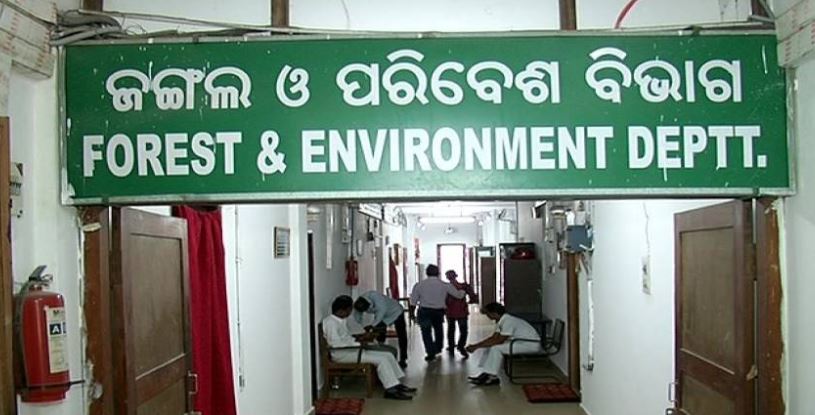Bhubaneswar: The Comptroller and Auditor General (CAG) has found ‘irregularities’ in plantation activities carried out by Odisha’s Forest Department which led to wasteful expenditure of public money.
The CAG report on Performance Audit of “Assessment of Plantation Activities” covering the period from 2013-14 to 2017-18, said that the acute shortfall in achievement of plantation targets during the period indicated fixation of unrealistic targets.
The long-term planning and fixation of the annual target could not be achieved due to a lack of coordinated planning among Ranges, Divisions and Forest Headquarters.
“It was necessary for the state to formulate their own State Forest Policy (SFP), in line with National Forest Policy, by considering local geo-climatic conditions. Failure to evolve SFP resulted in inadequate planning in the enhancement of green cover in the state. Forest Divisions were working without approved working plans/working schemes,” the report said.
Maintenance of plantation journals also lacked due care by the field functionaries as the details of plantations like pre and post-planting data, complete year-wise expenditure with abstract, Range Officer’s (ROs) quarterly inspections, authentication by the in-charge of plantation (Forester/ Forest Guard) and ROs were not incorporated due to which audit could not authenticate the execution of plantations, it said.
Though ‘Sal’ species is the principal indigenous species of Odisha, the ‘Teak’ was planted as major species, thereby affecting the originality of the vegetation and biodiversity, the report said, adding that there was no coordination at the level of Divisional Forest Officers (DFOs) and District Rural Development Authorities (DRDAs) in planning the plantation projects executed under MGNREGS in a division.
Neither the DFOs nor the department had the information on total job card holders available in a division which affected the plantation execution, said Accountant General Viswanath Singh Jadon at a press conference Monday.
The department incurred unfruitful expenditure worth Rs 13.17 crore as 191 out of 485 plantations were not successful, the report said, adding that the reasons for failure were the improper selection of plantation sites in dense forest and delay in submission of plantation project proposals by Divisional Forest Officers.
This apart, the survival of plantations executed under MGNREGS was adversely affected due to the non-release of funds from the second year onwards for maintenance operations, the report said.
The target for compensatory afforestation programmes under CAMPA was not achieved within the stipulated period of three years and hence, could not compensate the forest cover against the diversion of forest land, it said.
The CAG said that its audit team and forest officers physically verified 41 plantations and found 20 failed plantations and seven partially successful plantations with an unfruitful expenditure of Rs 2.67 crore.
The aerial survey of the plantation sites using UAVs revealed the concentration of plantation activities in easily accessible areas like land along the pathways, leaving the degraded patches in the middle of dense forest unplanted. Even though few teak species survived, the quality of growth in respect of height attained was not up to the mark.
It was observed that soil moisture conservation activities like digging staggered trenches were either not taken up or have been executed inefficiently, and trenches were not dug perpendicular to the terrain slope. Hence, the plantations were failed plantations with an unfruitful expenditure of Rs 68.36 lakh.
Irregular release of funds in one instalment during the first year of the bamboo plantation without ensuring the survival percentage in violation of norms of guidelines was also noticed, the report said, adding that although planting of seedlings was actually not taken up in the Aided Natural Regeneration (ANR) without gap plantation but the cost norm provided for watch and ward during the entire regeneration period of four years. This inappropriate provision led to an avoidable expenditure of Rs 63.19 crore.
Though various components of plantation works of Block plantations and Urban plantations were similar, the provision of man-days for urban plantations was fixed unreasonably higher which led to an avoidable extra expenditure of Rs 39.80 crore, the CAG found.
Excess expenditure was incurred under different components or outside the cost norms led to avoidable/wasteful expenditure of Rs 99 lakh. Irregular allotment of funds for fencing and third-year maintenance under Urban Tree Plantation led to the irregular expenditure of Rs 14.82 crore, it said.
As financial procedures were not followed for which Rs 69.12 lakh was spent towards watering charges without inviting tender, the report said.
Avenue plantations were completely damaged due to the widening of roads and funds for such damages were not raised against User Agencies (UAs) to compensate the damaged plantations due to a lack of coordination and inefficient monitoring, the CAG said.
Similarly, the Bamboo plantations were executed inside forests having a canopy cover of more than 40 per cent. The growth of clumps was not optimum in such sites because of poor light availability and as a result, the sites failed.
The variation in performance of different plantations was attributed to variation in site quality, species taken and level of management. Selection of wrong sites and poor management had resulted in the failure of plantations in 251 sites, as found in the Audit.
Inspection and monitoring by field level officers, in particular the Range Officers, was deficient compared to prescribed norms, the report said.
PTI
